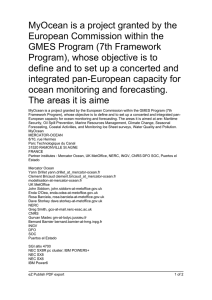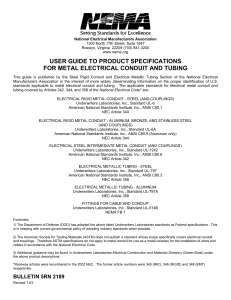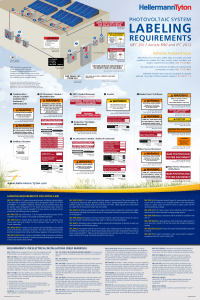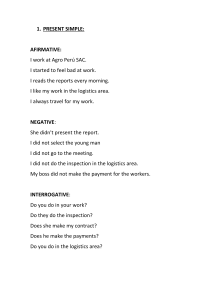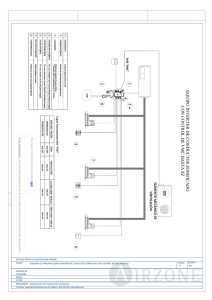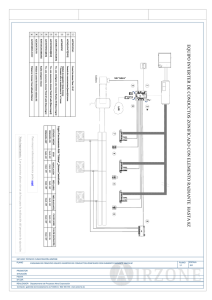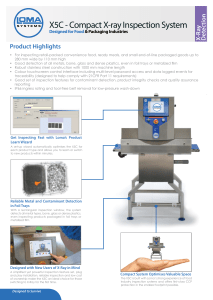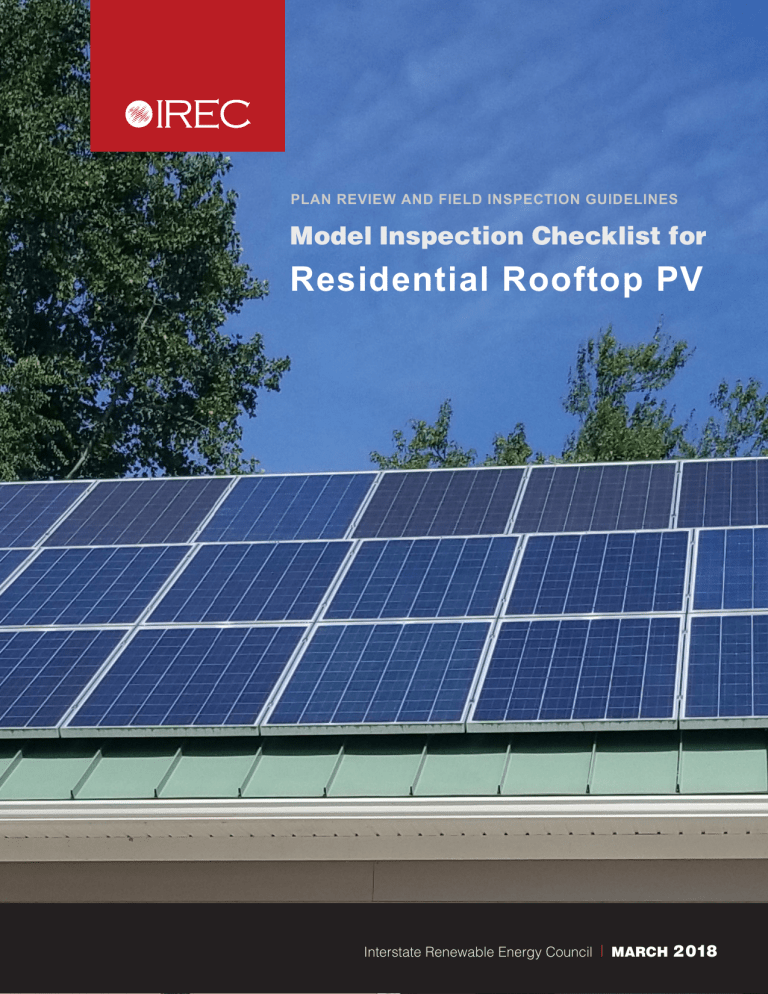
PLAN REVIEW AND FIELD INSPECTION Model Inspection Checklist for GUIDELINES Model Inspection Residential RooftopChecklist PV for Residential Rooftop PV l PLAN REVIEW AND FIELD INSPECTION GUIDELINES l Interstate Renewable Energy Council l MARCH 2 018 IREC | RESIDENTIAL PV INSPECTION CHECKLIST - 1 l PLAN REVIEW AND FIELD INSPECTION GUIDELINES l Model Inspection Checklist for Residential Rooftop PV ABOUT THE CHECKLIST This document provides basic guidelines for reviewing the permit plan application and inspecting most residential rooftop PV systems. The document includes solar-specific code requirements, but there may be other structural or electrical requirements that apply as well. While not all-inclusive, these guidelines outline the major steps of the plan review and field inspection processes for the majority of residential rooftop systems. AHJs can use this document to create custom jurisdictional checklists with modifications to match specific state and local code requirements. The checklists can then be used by reviewers, inspectors, and installers. This document is adapted from the 2013 Model Inspection Checklist, developed by Sky Stanfield and Don Hughes. 2018 RELEASE NOTES The Interstate Renewable Energy Council, Inc. (IREC) is pleased to release this resource for both the plan review and field inspection of residential rooftop PV systems, now updated to the most recent NEC and International Building, Residential, and Fire Codes. Since the 2013 release of this document, solar capacity continues to grow exponentially, as has the number of solar professionals. Best practices and guidance documents such as this are increasingly important to ensure consistency of practice in diverse jurisdictions throughout the country. For municipalities, this document can serve a variety of important functions. It can serve as a valuable job aid for both new and experienced inspectors. Using a checklist can improve inspection consistency and help ensure high-quality, safe installations. A municipality may also use the guidelines to generate a “correction notice” for installers – that lists commonly occurring installation errors. For solar installers, this document may save time and resources. Using a checklist can help an installer address the AHJ’s concerns prior to inspection. As with inspectors, the inspection guidelines can help educate and refresh installers about the number and variety of requirements that must be met for a code-compliant installation. Finally, as code requirements change and municipalities adopt local requirements, the guidelines can be used to highlight the changes. IREC | RESIDENTIAL PV INSPECTION CHECKLIST - 2 0 All National Electrical Code (NEC) references are to the 2017 National Electrical Code unless otherwise noted. 0 All International Residential Code (IRC), International Building Code (IBC) and International Fire Code (IFC) references are to the 2018 versions unless otherwise noted. DOCUMENT ORGANIZATION The 2018 version of this document separates requirements that are best verified during the review of the permit plan application prior to field inspection. Field inspection requirements are categorized under a main component, although some requirements are applicable to more than one area of the installation. SEC TIONS PLAN REVIEW page Structural Electrical Systems with batteries 4 5 7 FIELD INSPECTION Racking Wiring methods Conductors Conduit, raceways, cable assembly Connectors Modules Equipment accessible ground level Inverter Point of utility interconnection Rapid shutdown Energy storage system Sign and labels IREC | RESIDENTIAL PV INSPECTION CHECKLIST - 3 8 8 8 9 10 10 11 12 12 13 13 14 PLAN REVIEW STRUCTURAL PLAN REVIEW 1. Rooftop systems are designed in accordance with the IRC or IBC. (IRC Section R324, IBC 1509.7) 2. Roof access points, paths and clearances need to comply with the IFC. (IFC 605.11.3.1 - 605.11.3.3.3) 3. Rooftop mounted PV panels and modules have the proper fire classification rating. (IRC Section R324.4.2 ) 4. All roofs have an access point that does not place ground ladders over openings such as windows or doors, are located at strong points of building construction, and in locations where the access point does not conflict with overhead obstructions such as tree limbs, wires, or signs. (IFC 605.11.3.1) 5. Roofs with slopes greater than 2:12 have solar panel layouts that meet the following criteria: (some exceptions apply, see diagrams in IFC) a. Hip Roofs: Panels/modules are located so that there is a 3-foot wide clear access pathway from the eave to the ridge on each roof slope where panels/modules are located. (IFC 605.11.3.2.1) b. Hips and Valleys: If panels/modules are placed on both sides of a hip or valley they are located no closer than 18 inches to a hip or valley. If the panels are located on only one side of a hip or valley that is of equal length, then the panels can be placed directly adjacent to the hip or valley. (IFC 605.11.3.2.3) c. Single Ridges: Panels/modules are located so that there are two 3-foot wide access pathways from the eave to the ridge on each roof slope where there are panels/modules installed. (IFC 605.11.3.2.2) d. Ridges: Panels/modules are located no higher than 3 feet from the top of the ridge in order to allow for fire department smoke ventilation operations. (IFC 605.11.3.2.4) e. Access pathways are located at a structurally sound location capable of supporting the load of fire fighters accessing the roof. (IFC 605.11.3.2.1) 6. Roof must be capable of supporting the weight of the PV system. IREC | RESIDENTIAL PV INSPECTION CHECKLIST - 4 ELECTRICAL PLAN REVIEW 1. PV modules are listed to UL 1703. (NEC 110.3, 690.4(B) & IBC 1509.7.4) NOTE: AC modules need to be listed to UL 1703 and UL 1741. 2. Inverters are listed to UL 1741. (NEC 690.4(B)) NOTE: grid-tied system inverters need to be identified for use in interactive power systems. 3. Residential one and two family dwelling limited to maximum PV system voltage of 600 volts dc. (NEC 690.7) 4. A complete grounding electrode system is present. The PV system equipment grounding conductors shall be connected to the grounding electrode system. (NEC 690.47(A)) 5. The calculated maximum source circuit current is the sum of parallel-connected PV module–rated short-circuit currents multiplied by 125 percent. (NEC 690.8(A)(1) 6. The calculated maximum output circuit current is the sum of all combined source circuits (690.8(A)(2)) 7. DC source circuit conductors are rated at either 125 % of the ampacity calculated above or the ampacity calculated above with conditions of use applied, whichever is greater (NEC 690.8 (B)(1 & 2)) 8. Inverter output circuit overcurrent protection device (point of connection to AC system breaker) is sized based on the maximum inverter output current x 125%. (NEC 690.8(A)(3), 690.8(B)(1) & 705.60(B)) 9. Overcurrent protection is required for the a. PV source circuit (modules and parallel connected modules). [Exception for strings of modules with no source of overcurrent exceeding the ampacity of the conductors or modules (NEC 690.9(A) Exception)] b. PV output circuit (conductors between source circuits and inverter) c. Inverter output circuit IREC | RESIDENTIAL PV INSPECTION CHECKLIST - 5 d. Battery circuit conductors and equipment. (NEC 690.9(A)) e. Overcurrent protective devices is not required for circuits with sufficient ampacity for the highest available current (NEC 690.9(A) Exception) 10. Where three or more strings are combined, a listed combiner box (UL1741) is used and fuses are required. (Note: there are listed inverters that can accomplish this without the use of a combiner box) a. When DC source circuits (strings) are connected in parallel without fusing, the current through a failed circuit can be the sum of the current connected from the other strings, therefore special consideration must be taken to ensure the sum of the total number of strings minus one does not exceed the module manufacturers series fuse rating, or conductor ampacity. (NEC 110.3(B), 690.9(A)) NOTE: there are a few exceptions where the module has a higher series fuse rating and a low ISC rating and 3 or more strings can be combined without fusing. 11. Overcurrent devices where required are rated at 125% of the ampacity calculated above or are rated as an assembly for continuous duty (690.9(B)) 12. For PV source and output circuits, a single overcurrent protection device per circuit may be used for each circuit in either the negative or positive conductor. The device must be in the same polarity for all circuits. 13. PV system disconnect must disconnect the PV system from all other systems. (NEC 690.13) 14. Disconnects or isolating devices are installed for all ungrounded conductors. (NEC 240.15 & 690.15) 15. Rapid shutdown initiation device labeled on the plans. Device must be either: service disconnecting means, PV system disconnecting means, or readily accessible switch that plainly indicates whether it is in the “off” or “on” position (NEC 690.12(C)) IREC | RESIDENTIAL PV INSPECTION CHECKLIST - 6 SYSTEMS WITH BATTERIES 1. Batteries other than lead-acid batteries must be listed (NEC 480.3) 2. A disconnect means is provided for all ungrounded conductors derived from a stationary battery system over 50 volts AC or 60 volts DC. (NEC 480.7 & 706.7) 3. Wiring and connections of inverters, PV source circuits, battery connections, etc., and all interconnections are performed by qualified personnel. (690.4(C)) 4. High interrupt, listed, DC rated fuses or circuit breakers are used in battery circuits. The AIC is at least 20,000 amps. (NEC 706.21(C) & 110.9) IREC | RESIDENTIAL PV INSPECTION CHECKLIST - 7 FIELD INSPECTION RACKING 1. Roof penetrations are flashed to prevent moisture from entering the roof. (IRC Chapter 9, Section R903, R324.4.3) 2. Racking and PV system support structures installed and torqued per manufacturers instructions and approved plans. WIRING METHODS CONDUCTORS 1. All PV system conductors are sized and identified per the approved plans. 2. Bonding fittings are used for ferrous metal conduits enclosing grounding electrode conductors. (NEC 250.64(E)) 3. Bonding fittings are used on concentric/eccentric knockouts with metal conduits for circuits over 250 volts to ground. (NEC 250.97) (see also exceptions 1 through 4) 4. For underground conductor installations, the burial depth is appropriate. (NEC 300.5(D)(3) & Table 300.5, 300.50 & Table 300.50) 5. For conductors installed where ambient temperatures exceed 30ºC conductor ampacities should be corrected for higher temperatures. (2017 NEC Table 690.31(A)) 6. PV source and output circuits must be separated from non-PV system circuit conductors and inverter output circuit conductors. (NEC 690.31(B)) 7. DC positive and negative conductors should not be identified with white or grey except for solidly grounded PV system conductors. (690.31(B)(1)) 8. Single conductor cables are secured within 12 inches of each box, cabinet, conduit body or other termination. (NEC 690.31(C)) 9. PV system conductors shall be grouped and identified. (2017 NEC 690.31) 10. Single conductor cables are secured by staples, cable ties, straps, hangers or similar fittings at intervals that do not exceed 4.5 feet. (NEC 690.31(C)) 11. Exposed single conductor wiring is a 90ºC, wet rated and sunlight resistant type USE-2 or listed PV wire. (NEC 690.31(C)) If the wiring is in a conduit, it is 90ºC, wet-rated type RHW-2, THWN-2, or XHHW-2. (NEC 310.15) IREC | RESIDENTIAL PV INSPECTION CHECKLIST - 8 12. DC conductors inside a building are in a metal raceway or MC metal-clad cable that complies with 250.118(10), or metal enclosures. (NEC 690.31(G)) 13. Flexible metal conduit smaller than 3/4” or Type MC cable smaller than 1”, where used, closely follows the surface of the building finish or of the running boards. (2017 NEC 690.31(G)(2) & IFC 605.11.2) 14. Properly sized equipment grounding conductor is routed with the circuit conductors. (NEC 690.45, 250.134(B) & 300.3(B) 15. Separate grounding electrodes, if used, are bonded together. (NEC 690.47, 250.50 & 250.58) CONDUIT, RACEWAYS, CABLE ASSEMBLY 1. All conduit, raceways, and cables sized and installed per the approved plans. 2. Terminals containing more than one conductor are listed for multiple conductors. (NEC 110.14(A) & 110.3(B)) 3. DC wiring in buildings is installed in metallic conduit or raceways. (IFC 605.11.2 & NEC 690.31(G)) 4. The markings on the conduits, raceways and cable assemblies are every 10 feet, within one foot of all turns or bends and within one foot above and below all penetrations of roof/ceiling assemblies, walls and barriers. (NEC 690.31(G)(4) IFC 605.11.1.4) 5. Rooftop DC Conduits are located as close as possible to the ridge or hip or valley and from the hip or valley as directly as possible to an outside wall to reduce trip hazards and maximize ventilation opportunities. (IFC 605.11.2) 6. Conduit runs between sub arrays and to DC combiner boxes are installed in a manner that minimizes total amount of conduit on the roof by taking the shortest path from the array to the DC combiner box. (IFC 605.11.2) IREC | RESIDENTIAL PV INSPECTION CHECKLIST - 9 7. DC Combiner Boxes are located so that conduit runs are minimized in the pathways between arrays. (IFC 605.11.2) 8. Expansion fittings must be installed where necessary to compensate for thermal expansion, deflection, and contraction. (300.7(B)) CONNECTORS 1. Connectors and terminals used for fine strand conductors are listed for use with such conductors. (NEC 1 10.3(B) &110.14(A)) 2. Crimp on terminals are listed and installed using a listed tool specified for use in crimping those specific crimps. (NEC 110.3(B) & 110.14) 3. Pressure terminals are listed for the environment and tightened to manufacturer recommended torque specifications. (NEC 110.3(B), 110.11, & 110.14(D)) 4. Connectors are listed for the voltage of the system and have appropriate temperature and ampere ratings. (NEC 110.3(B) & 110.14) 5. Twist on wire connectors are listed for the environment (i.e. wet, damp, direct burial, etc.) and installed per manufacturer’s instructions. (NEC 110.3(B), 110.11, 110.14 & 300.5(B)) 6. Power distribution blocks are listed and rated for DC if used with DC PV circuits. (2017 NEC 314.28(E) & 376.56 690.4) MODULES 1. Module manufacturer, make, model, and number of modules match the approved plans. (IBC 107.4 - Amended Construction Documents)Modules are properly marked and labeled. (NEC 110.3, 690.4(B) & 690.51 or 690.52) 2. Modules are attached to the mounting structure according to the manufacturer’s instructions and the approved plans. (NEC 110.3(B), 2009 & 2012 IBC 107.4) 3. Module connectors are tight and secure. (NEC 110.3(B) & 110.12) 4. PV modules are in good condition (i.e., no broken glass or cells, no discoloration, frames not damaged, etc.). (NEC 110.12(B)) 5. Grounding - modules are bonded in accordance with manufacturer’s installation instructions using the supplied hardware or listed equipment specified in the instructions and identified for the environment (NEC 110.3(B)) & 690.43(A)) 6. If the racking system is used to bond the modules, the module/rack assembly is listed to bonding attribute of UL 2703. 7. Where PV circuits are embedded in built-up, laminate, or membrane roofing materials in roof areas not covered by PV modules and associated equipment, the location of circuits shall be clearly marked. (NEC 690.31(G)(1)) IREC | RESIDENTIAL PV INSPECTION CHECKLIST - 10 EQUIPMENT ACCESSIBLE AT GROUND LEVEL 1. Equipment locations, models, and specifications match the approved plans. 2. Connection from PV system to grounding electrode system made per the approved plans. (NEC 690.47) 3. Overcurrent devices in the PV DC circuits are listed for use in PV system and ratings match the approved plans. (NEC 110.3(A),(B), 690.9(B)) 4. Disconnects used in PV systems must be rated for the maximum short circuit current and voltage. A DC PV system disconnecting means shall be marked for use in PV systems or be suitable for backfeed operation. (NEC 110.3 & 690.13(E) and (F) 5. Isolating devices or disconnects are installed for the PV equipment, either integrated into the equipment or within 10’ of the equipment. (NEC 690.15) 6. All interior and exterior DC conduit, enclosures, raceways, cable assemblies, junction boxes, combiner boxes, and disconnects on buildings are marked. “The markings say “WARNING: PHOTOVOLTAIC POWER SOURCE” and have 3/8 inch (9.5 mm) minimum-sized white letters on a red background. The signs are made of reflective weather resistant material. (IFC 605.11.1.1, 605.11.1.2 & NEC 690.31(G)(3)) 7. Connectors that are readily accessible and operating at over 30 volts DC or 15 volts AC require a tool for opening. (NEC 690.33(C)) 8. PV source and output circuits in readily accessible locations and operating over 30V must be guarded or in a raceway. IREC | RESIDENTIAL PV INSPECTION CHECKLIST - 11 INVERTER 1. Inverter is properly secured with manufacturers required clearances (NEC 110.3(B), 110.13)) 2. AC and DC terminations are properly torqued (NEC 110.14(D)) 3. Verify inverter or other listed equipment provides DC ground-fault protection for the DC PV array (NEC 690.41(B). 4. Verify inverter or other listed equipment provides DC arc-fault protection where PV systems operate over 80V (NEC 690.11). 5. Required labels per Signage Requirements Table installed. POINT OF UTILITY INTERCONNECTION 1. Point of connection is either on the supply side of the service disconnecting means or at a dedicated breaker or disconnect on the load side of the service disconnecting means. (2017 NEC 705.12(A) & (B)(1)). 2. For load side connections, total rating of the overcurrent devices supplying a panelboard plus 125% of the inverter output current does not exceed 120% of the rating of the panelboard busbars. (NEC 705.12(B)(2)(3)(a)) 3. For load side connections, PV interconnect breaker is located at the opposite end of the bus from the feeder connection, unless the bus assembly has ampacity rating equal to or greater than the sum of 125% of the inverter output current and the rating of the overcurrent device protecting the panelboard. (NEC 705.12(B)(3)) 4. For supply-side connections, the sum of the ratings of all OCPDs connected to the power source must not exceed the rating of the service (NEC 705.12(A).Overcurrent protection for supply-side connected power source conductors must be provided within 3m (10’) of the point of interconnection to the service (NEC 705.31) IREC | RESIDENTIAL PV INSPECTION CHECKLIST - 12 5. PV system disconnecting means labeled “PV SYSTEM DISCONNECT” and readily accessible (NEC 690.13(A) & (B). Disconnect may be an externally operable general-use switch or circuit breaker, or other approved means. 6. Required labels per Signage Requirements Table installed. RAPID SHUTDOWN 1. Rapid shutdown initiation device installed and located per approved plans. For one and two family dwellings device must be outside at a readily accessible location. (690.12(C)) 2. Installed rapid shutdown equipment, other than the initiation device, must be listed for the application (690.12(D). Rapid shutdown equipment must control PV system conductors to within the limits of 690.12(B) 3. Required labels per Signage Requirements Table installed. ENERGY STORAGE SYSTEM BATTERIES 1. Flexible battery cables do not leave the battery enclosure. (NEC 400.12) 2. Flexible, fine strand cables are only be used with terminals, lugs, devices, and connectors that are listed and marked for such use. (NEC 110.3(B) & 110.14) 3. Area is well ventilated and the batteries are not installed in living areas. (NEC 408.10 & 706.10(A)) 4. Live parts of battery systems are guarded to prevent accidental contact by persons or objects. (NEC 706.10(B)) 5. Working space and illumination are provided around the battery installation. (706.10 (C),(D) & (E) 6. Proper diagrams or placards are provided at the building electric service equipment and other power source locations. (NEC 706.11) IREC | RESIDENTIAL PV INSPECTION CHECKLIST - 13 SIGNS AND LABELS Labels are phenolic where exposed to sunlight. Labels required on conduit are permanent, weather resistant and suitable for the environment. Labels have a red background with white lettering. The following labels are required as applicable: TABLE: SIGNAGE REQUIREMENTS FOR PV SYSTEMS Code Section Location of Label Text NEC 690.13(B) On the PV system disconnect as Identified in Figure 690.1(B) PV SYSTEM DISCONNECT NEC 690.13(B) Disconnects with power on line and load terminals when in the open position WARNING ELECTRIC SHOCK HAZARD TERMINALS ON THE LINE AND LOAD SIDES MAY BE ENERGIZED IN THE OPEN POSITION NEC 690.53 On the DC disconnects (1) Maximum voltage Informational Note to (1): See 690.7 for voltage. (2) Maximum circuit current Informational Note to (2): See 690.8(A) for calculation of maximum circuit current. (3) Maximum rated output current of the charge controller or dc-to-dc converter (if installed) NEC 690.54 At interactive points of interconnection, usually the main service RATED AC OUTPUT CURRENT ___ AMPS NORMAL OPERATING AC VOLTAGE ___ VOLTS NEC 690.56(B) 705.10 At the electrical service and at the PV inverter if not at the same location A directory providing the location of the service disconnecting means and the photovoltaic system disconnecting means NEC 690.56(C) At the service disconnecting means RAPID SHUTDOWN LABELS FOR TYPE OF SYSTEM INSTALLED NEC 705.12(B)(2) (3)(b) Inverter output OCPD WARNING:POWER SOURCE OUT PUT CONNECTION — DO NOT RELOCATE THIS OVERCURRENT DEVICE. NEC 690.55 Battery enclosure MAXIMUM OPERATING VOLTAGE, EQUALIZATION VOLTAGE POLARITY OF GROUNDED CONDUCTORS IFC 605.11.1.4 On conduit, raceways, and enclosures, mark every 10 feet, at turns, above/below penetrations WARNING: PHOTOVOLTAIC POWER SOURCE NEC 705.12(B)(3) Equipment containing overcurrent devices in circuits supplying power to a busbar or conductor supplied from multiple sources shall be marked to indicate the presence of all sources. Dual Power Source. Second source is a solar PV system. IREC | RESIDENTIAL PV INSPECTION CHECKLIST - 14 l PLAN REVIEW AND FIELD INSPECTION GUIDELINES l Model Inspection Checklist for Residential Rooftop PV CONTRIBUTORS Rebekah Hren Jim Rogers Shawn Martin, ICC Kristen Ferguson, IREC FOR ADDITIONAL IREC RESOURCES ON SOLAR PV INSPECTIONS, PLEASE SEE: Expedited Permit Process for PV Systems by Bill Brooks (July 2012) http://www.solarabcs.org/about/publications/reports/expedited-permit/pdfs/Expermitprocess.pdf Field Inspection Guidelines for PV Systems, prepared by Bill Brooks for IREC, June 2010, available at: http://irecusa.org/wp-content/uploads/2010/07/PV-Field-Inspection-Guide-June-2010-F-1.pdf Sharing Success: Emerging Approaches to Efficient Rooftop Solar Permitting, May 2012, available at: http://www.irecusa.org/wp-content/uploads/FINAL-Sharing-Success-wcover-revised-final052012.pdf Simplifying the Solar Permitting Process: Residential Solar Permitting Best Practices, IREC and the Vote Solar Initiative, September 2013, available at: http://www.irecusa.org/wp-content/uploads/2013/09/expanded-best-practices.pdf This material is based upon work supported by the Department of Energy, Office of Energy Efficiency and Renewable Energy (EERE), under Award Number DE-EE0007323. DISCLAIMER: This report was prepared as an account of work sponsored by an agency of the United States Government. Neither the United States Government nor any agency thereof, nor any of their employees, makes any warranty, express or implied, or assumes any legal liability or responsibility for the accuracy, completeness, or usefulness of any information, apparatus, product, or process disclosed, or represents that its use would not infringe privately owned rights. Reference herein to any specific commercial product, process, or service by trade name, trademark, manufacturer, or otherwise does not necessarily constitute or imply its endorsement, recommendation, or favoring by the United States Government or any agency thereof. The views and opinions of authors expressed herein do not necessarily state or reflect those of the United States Government or any agency thereof. IREC | RESIDENTIAL PV INSPECTION CHECKLIST - 15
